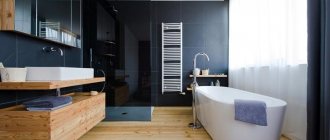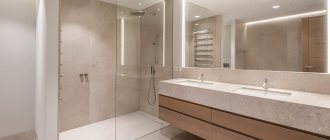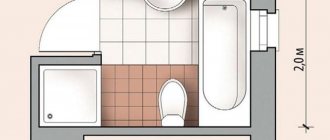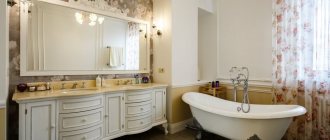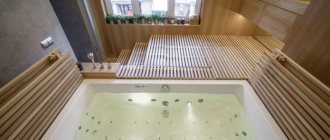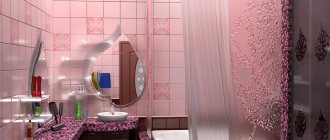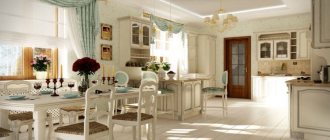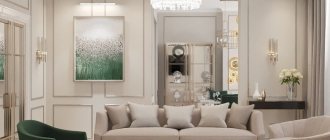How to turn routine hygiene procedures into a small miracle, surrounding yourself with luxury and exquisite beauty? The answer is simple: a bathroom in an oriental style will help.
Unique design and bold ideas will transform a standard room into a wonderful world of cleanliness.
However, before starting the renovation, you need to choose which East is most attractive, because oriental design is based on the traditions of such countries as:
- India;
- Japan;
- China;
- Egypt;
- Morocco;
- Türkiye.
A nuance: the oriental style is demanding on the size of the room, so for small bathrooms it is better to use Japanese and Chinese designs, for spacious ones - Moroccan, Turkish, Egyptian.
Luxury India
A bathroom in the oriental style of India is a luxury and richness of natural colors and materials.
The color range includes the following shades:
- all kinds of brown, wood, ocher;
- blue;
- green;
- orange;
- red.
Important! The most recognizable Indian pattern is paisley, or oriental paisley.
Ceramic tiles with this pattern will decorate the walls and floor, but the pattern should not be overly colorful.
Designers offer several more options for wall decoration:
- wooden carved panels or gratings coated with waterproof varnish;
- homogeneous plaster, on top of which a mosaic panel is placed;
- The walls are painted in rich colors - fuchsia, green, blue.
If possible, one of the walls is decorated with a niche topped with several domes. The inner surface is covered with plaster and decorated with carvings. Even a shallow niche immediately gives the bathroom an Indian flavor.
It can accommodate a sink or open wooden shelves.
Plumbing is suitable either traditional white or black with gold, red or beige.
Textiles are an important part of the Indian interior, so towels, rugs, and robes made of natural fabrics with national motifs would be appropriate in the bathroom.
Laconism of Japanese style
A Japanese-style bathroom is strikingly different from previous interiors. This applies to the shapes and color palette of the design. The motto of the direction is laconic forms and thoughtful simplicity in every detail of the decor.
Color spectrum
The interior is filled with a color palette of natural, muted shades that help create the right atmosphere for relaxation.
The design may contain:
- yellow;
- beige;
- peach;
- coffee;
- pink;
- terracotta;
- blue;
- black.
The presented variety of colors is not used by everyone at the same time; it is enough to focus on two shades to prevent oversaturation of the interior with colors.
Finishing materials
Oriental style wall cladding, originally from Japan, is distinguished by a variety of design ideas. Suitable bathroom solutions:
- Matte ceramic tiles with a rough texture that imitates bamboo, straw, rice paper or wood.
- Tiles that create the illusion of rectangular wood panels.
- A ceramic panel depicting mountain landscapes, chrysanthemums, cherry blossoms or inscriptions in hieroglyphs with wishes.
- Original mosaic lined with sea pebbles.
- Combined cladding, when painted or plastered wall surfaces are decorated with a large lattice.
The Japanese-style bathroom floor is usually dark in color; this design provides logical completeness to the interior design. Additional decoration is provided by mats made of bamboo and sisal.
Interior items
It is better to divide a large room into zones; these can be visual techniques or real partitions - shoji; the delimitation function is successfully performed by mobile screens. Typically, a Japanese bathhouse contains areas intended for changing clothes, showering and bathing.
For a Japanese-style bathroom, white sanitary ware is selected, which is complemented by taps and mixers made of copper and bronze. The highlight of the interior can be an ofuro - a cedar or cypress barrel, into which one immerses for relaxation and relaxation. The cost of such pleasure is quite high. An acrylic bathtub decorated with wooden paneling can replace a remarkable design detail.
A continuation of the concept of Japanese style in the bathroom is dark furniture made of polished wood. As in other interiors with an oriental flavor, models with low legs are chosen. A distinctive feature of the furniture is its clear rectangular outline without decoration. Floor-standing units can replace hanging and built-in cabinets. You won't see carvings or complex shapes here.
Comment! Japanese bathroom designs often feature stones. They are found in the decoration of walls, floors, or simply as original decor to create the desired oriental style ambience.
Lighting
Correctly selected lighting adds completeness to the oriental style. This applies to the location of lighting fixtures in the bathroom, their shape and radiation intensity. Blinding and cold light streams are not appropriate. Preference is given to warm and moderate lighting, and each functional area should have its own source.
Wall and ceiling fixtures for Japanese-style bathrooms are chosen in cubic shapes. Frosted glass is framed with wooden or bamboo slats.
The versatility of the oriental style allows everyone to find a suitable design solution for their own bathroom. In every direction, be it the Arabian riot of luxury or Japanese restraint, elegance and sophistication can be traced.
Recommended Posts
Finishing the toilet with plastic panels
Lighting a small bathroom
Design of a combined bathroom with shower
Warm floor in the bathroom under tiles
Small bathroom design
How to remove mold in the bathroom
Mysterious Egypt
You can decorate an Egyptian-style bathroom in an oriental style; photos of the most interesting designs are posted below. This type of interior design is characterized by rich luxury, so it is better to implement it in a spacious bathhouse.
The range of colors predominates among yellow tones - from sand to gold; brown is used as an additional color - from beige to dark chocolate.
The walls and ceiling are finished with textured plaster, painted in golden tones, or matching ceramic tiles. Elaborate architectural details such as arches and columns are very appropriate.
Furniture made of expensive wood is decorated with gilded handles and legs in the form of animal paws. Gilding is also applied to the mirror.
It is also better to purchase plumbing fixtures in sand or beige colors, with elements decorated with gold paint. Instead of a standard bathtub, you can put a large Jacuzzi on a pedestal.
East in the interior - choosing the main direction
Among several main areas, the most popular are the following:
- Egyptian;
- Arab;
- Turkish.
Each of them is characterized by its own sets of materials, color techniques and design solutions that help convey the appropriate atmosphere.
There is one feature that unites all eastern directions - close attention to literally every small detail.
A real fairy tale
Luxury and splendor, mystery and beauty - all this is embodied in the national culture of Morocco, which for Europeans has become the personification of a fairy tale. A Moroccan bathroom in an oriental style is the most elegant, defiantly decorative, but at the same time perfect in style and elegance.
Amazing color saturation is at the heart of Moroccan design. The atmosphere is created by the following tones:
- deep colors of red;
- yellow (from sand to ocher);
- orange;
- brown;
- necessarily ultramarine, turquoise, cobalt.
Another option to decorate your bathroom in the spirit of Morocco is to use black and white colors.
Of particular importance are the architectural elements characteristic of this distant African country and which have become an integral part of the East for Europeans:
- pointed arches, in the form of which windows or doors are designed;
- lancet niches for installing mirrors or shelves.
For wall decoration, it is best to use tadelakt mineral plaster; with its help, the effect of marble walls is created. The varied layout of tiny, no more than 6 cm each, ceramic tiles looks no less beautiful. Bright or black and white patterns in the form of stars and geometric shapes, floral patterns, and Arabic script look amazing.
Mosaics can decorate not only the walls, but also the countertop of the sink, flowing from the vertical plane to the floor.
To harmonize the style, you need to choose plumbing fixtures made of dark stone, faucets made of bronze or copper, and a faucet with an intricate spout.
The furniture purchased is low, simple in shape, with massive wooden handles.
Brass lamps decorated with chasing, metal carvings and colored glass inserts will become an excellent style accent.
Indian bathroom decor ↑
Indian decor is primarily based on a connection with nature. This is the most environmentally friendly crop in the world. The wood is not painted, but only slightly varnished, the stone is slightly polished, and the colors are close to natural. The main colors of Indian-style interiors are, first of all, red-brown and simply brown - the color of spices.
Bathroom in Indian colors
Blue is the color of the supreme deity of India. It is one of the main ones in the interior and, of course, is especially characteristic of the bathroom.
Indian tile finishing
Green is the color of the many forests of India, and orange represents the Indian sun and the color of the clothing of Buddhist monks.
Unusual accessories in the bathroom
Natural colors of Indian interiors in the bathroom
Furniture
In a Chinese bathroom, everything should be minimalistic, so a cabinet or cabinet will be enough.
Arabic furniture also should not be numerous. Traditionally, a large chest of drawers with a mirror is used. It is also acceptable to use small racks with shelves.
The Japanese, on the contrary, have a large selection: small wooden benches, hanging cabinets, elegant racks, shelves. They should be in ethnic Japanese colors, but not too bright.
Egyptian style requires a closet where everything you need will be located. We recommend using hanging models.
Bright, stunning wall design
Koi carps hold an important place in Japanese and Chinese culture. Generally speaking, in Japan they are symbols of love, friendship and courage, and in China - wealth and prosperity. The koi pattern wallpaper adds character and interest to the bathroom below. Don't like the fish pattern? Choose wall coverings with Asian characters, cherry blossom branches or other iconic oriental motifs!
Chinese
For traditional Chinese style, an important thing is the arrangement of objects. The ancient teaching of harmony, Feng Shui, teaches how to choose the right interior for a room so that a person feels comfortable.
Chinese design involves dark shades. Of the bright colors, red occupies an important place. It is used to draw attention to something, to create emphasis.
Unlike the Arabic style, the Chinese prefer to use restrained and laconic patterns. Suitable materials for wall decoration:
- Wood panels;
- Bamboo wallpaper;
- Fabric panels.
The floor is made from natural material. The best choice is stone tiles, which cope well with moisture and are pleasant to look at.
The ceiling should be decorated as simply as possible. The only rule is don’t make a mirror ceiling: it goes against the style.
Fabric sheets or glass partitions are suitable for zoning a room. Otherwise, it is better to avoid redundancy. This contradicts the teachings of Feng Shui, interfering with the circulation of internal energy.
Decorative accessories
Chinese Feng Shui involves careful access to accessories. An important element is mirrors. Two mirrors should be placed opposite each other. Otherwise, it is better to avoid redundancy: a few Chinese vases or figurines will be enough.
The Arab tradition prefers a large mirror in a wide frame opposite the bathtub. Accessories should be functional: don't add something just for show. This can ruin the overall composition.
It is better to decorate a Japanese bathroom with various jugs and vases with dried flowers. Choose rectangular or square mirrors with frames.
For Egyptian decor, choose colorful decorations in an ethnic style. But don’t overdo it: there should be only a few of them.
